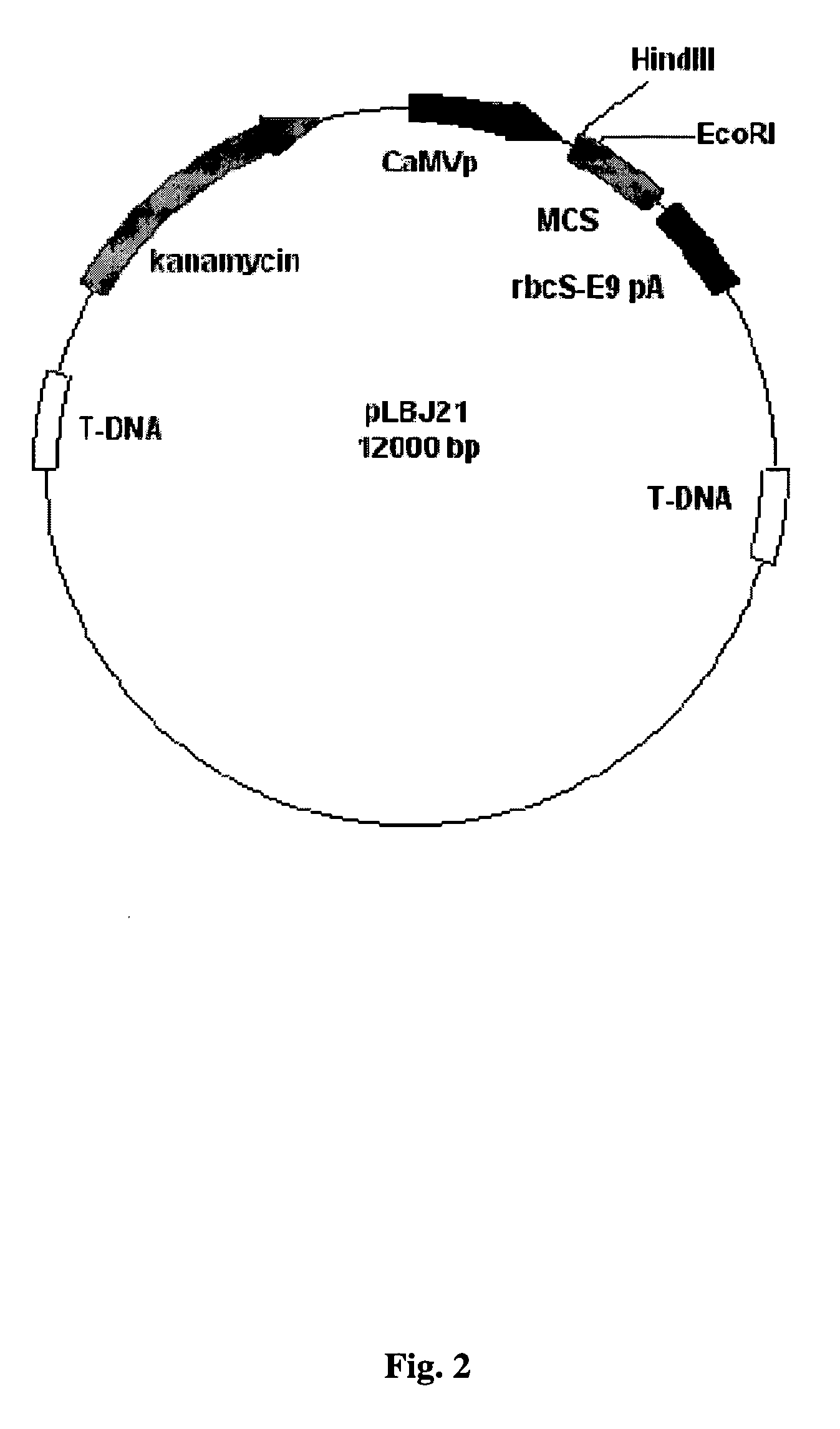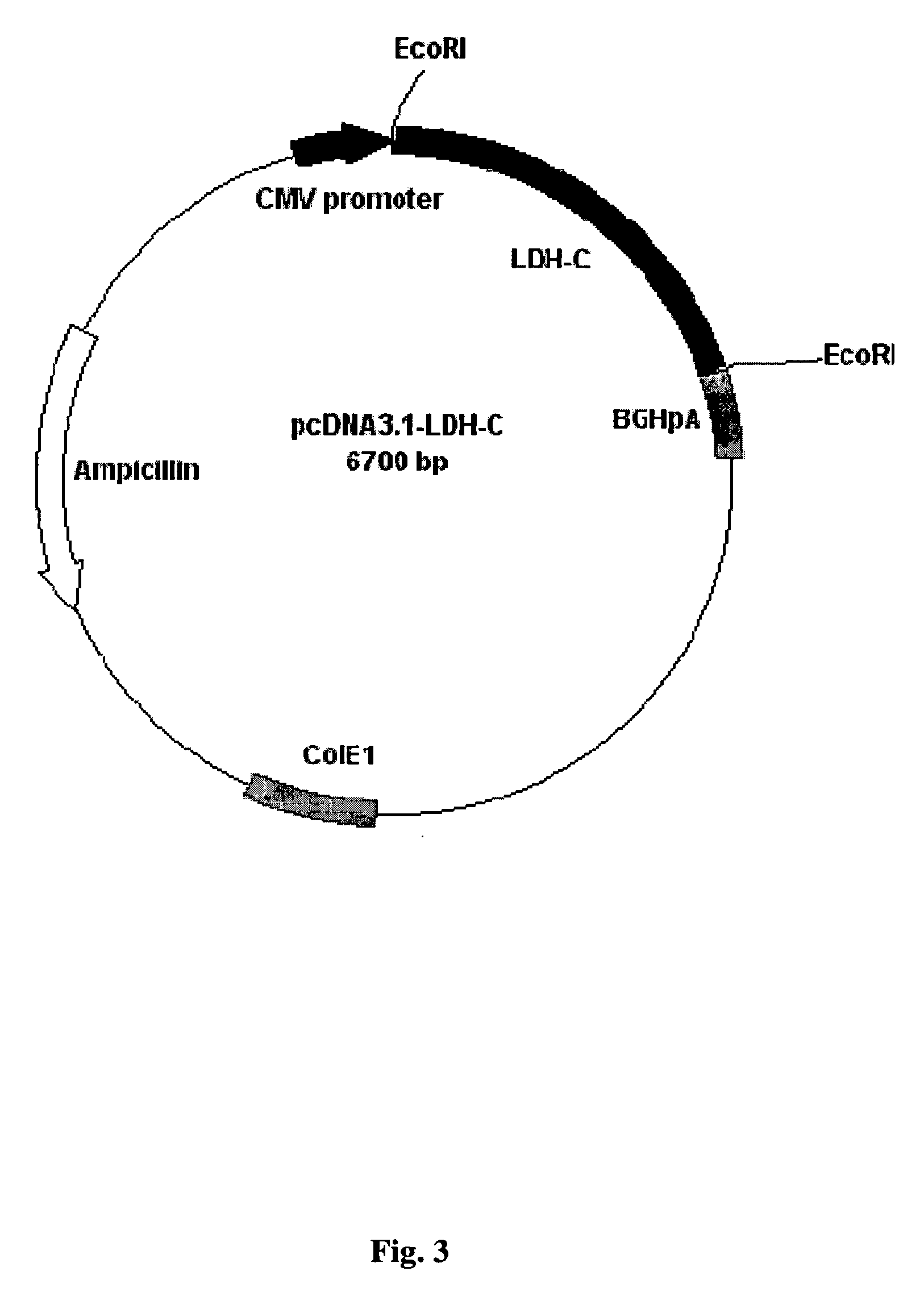Animal immunocontraceptives expressed in plants and uses thereof
a technology of immunocontraceptives and plants, applied in the field of immunocontraceptives, can solve the problems of spreading fatal diseases to people and domestic animals, destroying crops and foodstuffs, and destroying crops at the same time, and achieve the effect of effective and humaneness
- Summary
- Abstract
- Description
- Claims
- Application Information
AI Technical Summary
Benefits of technology
Problems solved by technology
Method used
Image
Examples
example 1
Cloning of Plasmid Containing Full Length Lactate Dehydrogenase-C cDNA
[0074] For the development of transgenic plants via Agrobacterium-mediated transformation the antigenic genes need to be cloned into a modified form of the Ti plasmid from Agrobacterium tumefaciens constructed by Schardl et al. (1987) with the purpose of simplifying the expression of foreign genes in plants. The plasmid was further engineered to contain EcoRI and HindIII sites and was called pLBJ21 (FIG. 2). This pLBJ21 plasmid was used to construct a plasmid containing a full length lactate dehydrogenase-C cDNA as described below.
[0075] Plasmid pDNA3.1-LDH-C was provided by Dr. Erwin Goldberg from Northwestern University, Evanston, Ill. This plasmid contains the cDNA of mice lactate dehydrogenase-C (LDH-C) between two EcoRI sites (FIG. 3). The plasmid was transformed into XL-1 blue electrocompetent cells (Stratagene). The plasmid was isolated using the Quiaprep Spin Plasmid kit (Quiagen) following the manufactu...
example 2
Cloning of Plasmid Containing a Peptide Epitope of Lactate Dehydrogenase-C
[0078] Plasmid pcDNA3.1-SPV was designed to express an immunodominant lactate dehydrogenase-C epitope. The synthetically constructed minigene SPV (Short Peptide Vaccine) includes amino acids 5-15 of lactate dehydrogenase-C coupled via a short spacer to a promiscuous T-cell epitope from tetanus toxin. The SPV was first constructed by a multi-step PCR using long oligonucleotides, and then the gene was cloned into appropriate vector. In this case, the synthetic gene was subcloned in a series of steps to create a peptide vaccine vector (see FIG. 5).
[0079] In the first step, a plasmid with the intact SPV region was used as a template for PCR so that the product would be comprised solely of the SPV sequence. As stated before, the sequence of this minigene includes amino acids 5-15 of lactate dehydrogenase-C (LDH-C). It does not contain a start ATG codon. By using PCR, the first 5 amino acids of LDH-C (amino acid 1...
example 3
Transformation of Plasmids Into Agrobacterium tumefaciens
[0081] Strain GV3101(pMP90) of Agrobacterium (Knocz and Schell, 1986) was frozen in LB media supplemented with 10% glycerol. From this glycerol stock a 5 ml culture was inoculated and grown overnight in a 30° C. incubator shaking at 200 rpms. A dense culture was obtained next morning and was used to make a stock of electrocompetent Agrobacterium. One μl of each plasmid (approximately 50 ng) was mixed with 20 μl of freshly prepared cells and the mixture was incubated on ice for 30 minutes. The cells were transferred to an electroporation chamber Micro Electro Chamber (Gibco BRL Life Technologies). The chambers were placed in the Cell Porator Electroporation System I (Gibco BRL Life Technologies) and the transformation was performed according to the manufacturer's instructions.
[0082] The transformed Agrobacterium were recovered in 250 μl of SOC media at 30° C. while shaking at 200 rpm for 1 hour. The cells were further plated ...
PUM
| Property | Measurement | Unit |
|---|---|---|
| Antigenicity | aaaaa | aaaaa |
Abstract
Description
Claims
Application Information
 Login to View More
Login to View More - R&D
- Intellectual Property
- Life Sciences
- Materials
- Tech Scout
- Unparalleled Data Quality
- Higher Quality Content
- 60% Fewer Hallucinations
Browse by: Latest US Patents, China's latest patents, Technical Efficacy Thesaurus, Application Domain, Technology Topic, Popular Technical Reports.
© 2025 PatSnap. All rights reserved.Legal|Privacy policy|Modern Slavery Act Transparency Statement|Sitemap|About US| Contact US: help@patsnap.com



